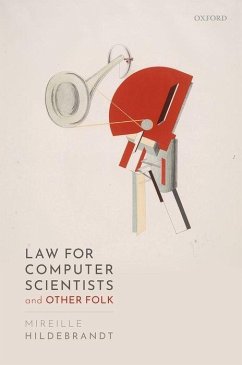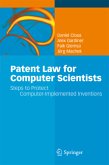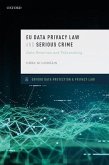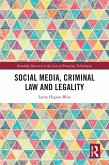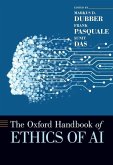Mireille Hildebrandt
Law for Computer Scientists and Other Folk
Mireille Hildebrandt
Law for Computer Scientists and Other Folk
- Gebundenes Buch
- Merkliste
- Auf die Merkliste
- Bewerten Bewerten
- Teilen
- Produkt teilen
- Produkterinnerung
- Produkterinnerung
This is a textbook on law for computer scientists and many others with no wish to become a lawyer, who are nevertheless in need of a proper introduction to how law operates and how it affects individuals, societies, and others. It introduces: privacy and data protection, cybercrime, copyright, private law liability and legal personhood.
Andere Kunden interessierten sich auch für
![The Risk-Based Approach to Data Protection The Risk-Based Approach to Data Protection]() Raphaël GellertThe Risk-Based Approach to Data Protection153,99 €
Raphaël GellertThe Risk-Based Approach to Data Protection153,99 €![Governing Cross-Border Data Flows Governing Cross-Border Data Flows]() Svetlana YakovlevaGoverning Cross-Border Data Flows174,99 €
Svetlana YakovlevaGoverning Cross-Border Data Flows174,99 €![Patent Law for Computer Scientists Patent Law for Computer Scientists]() Daniel ClosaPatent Law for Computer Scientists41,99 €
Daniel ClosaPatent Law for Computer Scientists41,99 €![EU Data Privacy Law and Serious Crime EU Data Privacy Law and Serious Crime]() Nóra Ni LoideainEU Data Privacy Law and Serious Crime118,99 €
Nóra Ni LoideainEU Data Privacy Law and Serious Crime118,99 €![Social Media, Criminal Law and Legality Social Media, Criminal Law and Legality]() Laura Higson-BlissSocial Media, Criminal Law and Legality202,99 €
Laura Higson-BlissSocial Media, Criminal Law and Legality202,99 €![Oxford Handbook of Online Intermediary Liability Oxford Handbook of Online Intermediary Liability]() Oxford Handbook of Online Intermediary Liability255,99 €
Oxford Handbook of Online Intermediary Liability255,99 €![The Oxford Handbook of Ethics of AI The Oxford Handbook of Ethics of AI]() The Oxford Handbook of Ethics of AI287,99 €
The Oxford Handbook of Ethics of AI287,99 €-
-
-
This is a textbook on law for computer scientists and many others with no wish to become a lawyer, who are nevertheless in need of a proper introduction to how law operates and how it affects individuals, societies, and others. It introduces: privacy and data protection, cybercrime, copyright, private law liability and legal personhood.
Hinweis: Dieser Artikel kann nur an eine deutsche Lieferadresse ausgeliefert werden.
Hinweis: Dieser Artikel kann nur an eine deutsche Lieferadresse ausgeliefert werden.
Produktdetails
- Produktdetails
- Verlag: Oxford University Press
- Seitenzahl: 342
- Erscheinungstermin: 6. Juli 2020
- Englisch
- Abmessung: 236mm x 157mm x 25mm
- Gewicht: 757g
- ISBN-13: 9780198860877
- ISBN-10: 0198860870
- Artikelnr.: 58666781
- Herstellerkennzeichnung
- Libri GmbH
- Europaallee 1
- 36244 Bad Hersfeld
- gpsr@libri.de
- Verlag: Oxford University Press
- Seitenzahl: 342
- Erscheinungstermin: 6. Juli 2020
- Englisch
- Abmessung: 236mm x 157mm x 25mm
- Gewicht: 757g
- ISBN-13: 9780198860877
- ISBN-10: 0198860870
- Artikelnr.: 58666781
- Herstellerkennzeichnung
- Libri GmbH
- Europaallee 1
- 36244 Bad Hersfeld
- gpsr@libri.de
Mireille Hildebrandt, Research Professor 'Interfacing Law and Technology', Free University Brussels
* Acknowledgements
* Reading Guide
* Abbreviations
* Table of Contents
* 1: Introduction: Textbook and Essay
* 1.1: Middle ground: architecture
* 1.2: Law in 'speakerspace'
* 1.3: Law in 'manuscriptspace'
* 1.4: Law in 'bookspace'
* 1.5: Law in cyberspace: a new 'onlife world'
* 1.6: Outline
* PART I WHAT LAW DOES
* 2.: Law, Democracy, and the Rule of Law
* 2.1: What is Law?
* 2.2: What is law in a constitutional democracy?
* 3.: Domains of Law: Private, Public, and Criminal Law
* 3.1: Private, public and criminal law: conceptual distinctions
* 3.2: Private law
* 3.3: Public law and criminal law
* 4.: International and Supranational Law
* 4.1: Jurisdiction in Western legal systems
* 4.2: International law
* 4.3: Supranational law
* 4.4: International rule of law
* PART II DOMAINS OF CYBERLAW
* 5.: Privacy and Data Protection
* 5.1: Human rights law
* 5.2: The concept of privacy
* 5.3: The right to privacy
* 5.4: Privacy and Data Protection
* 5.5: Data protection law
* 5.6: Privacy and data protection revisited
* 6.: Cybercrime
* 6.1: The problem of cybercrime
* 6.2: Cybercrime and public law
* 6.3: The EU cybercrime and cybersecurity directives
* 7.: Copyright in Cyberspace
* 7.1: IP law as private law
* 7.2: Overview of IP rights
* 7.3: History, objectives and scope of copyright protection
* 7.4: EU copyright law
* 7.5: Open source and free access
* 8.: Private Law Liability for Faulty ICT
* 8.1: Back to basics
* 8.2: Tort law in Europe
* 8.3: Third-party liability for unlawful processing and other cyber
torts
* PART III FRONTIERS OF LAW IN AN ONLIFE WORLD
* 9.: Legal Personhood for AI?
* 9.1: Legal subjectivity
* 9.2: Legal agency
* 9.3: Artificial agents
* 9.4: Private law liability
* 10.: 'Legal by Design' or 'Legal Protection by Design'?
* 10.1: Machine learning (ML)
* 10.2: Distributed Ledger Technologies (DLTs), smart contracts and
smart regulation
* 10.3: 'Legal by Design' or 'Legal Protection by Design'?
* FINALS
* 11.: Closure: on ethics, code and law
* 11.1: Distinctions between law, code and ethics
* 11.2: The conceptual relationship between law, code and ethics
* 11.3: The interaction between law, code and ethics
* 11.4: Closure: the force of technology and the force of law
* Reading Guide
* Abbreviations
* Table of Contents
* 1: Introduction: Textbook and Essay
* 1.1: Middle ground: architecture
* 1.2: Law in 'speakerspace'
* 1.3: Law in 'manuscriptspace'
* 1.4: Law in 'bookspace'
* 1.5: Law in cyberspace: a new 'onlife world'
* 1.6: Outline
* PART I WHAT LAW DOES
* 2.: Law, Democracy, and the Rule of Law
* 2.1: What is Law?
* 2.2: What is law in a constitutional democracy?
* 3.: Domains of Law: Private, Public, and Criminal Law
* 3.1: Private, public and criminal law: conceptual distinctions
* 3.2: Private law
* 3.3: Public law and criminal law
* 4.: International and Supranational Law
* 4.1: Jurisdiction in Western legal systems
* 4.2: International law
* 4.3: Supranational law
* 4.4: International rule of law
* PART II DOMAINS OF CYBERLAW
* 5.: Privacy and Data Protection
* 5.1: Human rights law
* 5.2: The concept of privacy
* 5.3: The right to privacy
* 5.4: Privacy and Data Protection
* 5.5: Data protection law
* 5.6: Privacy and data protection revisited
* 6.: Cybercrime
* 6.1: The problem of cybercrime
* 6.2: Cybercrime and public law
* 6.3: The EU cybercrime and cybersecurity directives
* 7.: Copyright in Cyberspace
* 7.1: IP law as private law
* 7.2: Overview of IP rights
* 7.3: History, objectives and scope of copyright protection
* 7.4: EU copyright law
* 7.5: Open source and free access
* 8.: Private Law Liability for Faulty ICT
* 8.1: Back to basics
* 8.2: Tort law in Europe
* 8.3: Third-party liability for unlawful processing and other cyber
torts
* PART III FRONTIERS OF LAW IN AN ONLIFE WORLD
* 9.: Legal Personhood for AI?
* 9.1: Legal subjectivity
* 9.2: Legal agency
* 9.3: Artificial agents
* 9.4: Private law liability
* 10.: 'Legal by Design' or 'Legal Protection by Design'?
* 10.1: Machine learning (ML)
* 10.2: Distributed Ledger Technologies (DLTs), smart contracts and
smart regulation
* 10.3: 'Legal by Design' or 'Legal Protection by Design'?
* FINALS
* 11.: Closure: on ethics, code and law
* 11.1: Distinctions between law, code and ethics
* 11.2: The conceptual relationship between law, code and ethics
* 11.3: The interaction between law, code and ethics
* 11.4: Closure: the force of technology and the force of law
* Acknowledgements
* Reading Guide
* Abbreviations
* Table of Contents
* 1: Introduction: Textbook and Essay
* 1.1: Middle ground: architecture
* 1.2: Law in 'speakerspace'
* 1.3: Law in 'manuscriptspace'
* 1.4: Law in 'bookspace'
* 1.5: Law in cyberspace: a new 'onlife world'
* 1.6: Outline
* PART I WHAT LAW DOES
* 2.: Law, Democracy, and the Rule of Law
* 2.1: What is Law?
* 2.2: What is law in a constitutional democracy?
* 3.: Domains of Law: Private, Public, and Criminal Law
* 3.1: Private, public and criminal law: conceptual distinctions
* 3.2: Private law
* 3.3: Public law and criminal law
* 4.: International and Supranational Law
* 4.1: Jurisdiction in Western legal systems
* 4.2: International law
* 4.3: Supranational law
* 4.4: International rule of law
* PART II DOMAINS OF CYBERLAW
* 5.: Privacy and Data Protection
* 5.1: Human rights law
* 5.2: The concept of privacy
* 5.3: The right to privacy
* 5.4: Privacy and Data Protection
* 5.5: Data protection law
* 5.6: Privacy and data protection revisited
* 6.: Cybercrime
* 6.1: The problem of cybercrime
* 6.2: Cybercrime and public law
* 6.3: The EU cybercrime and cybersecurity directives
* 7.: Copyright in Cyberspace
* 7.1: IP law as private law
* 7.2: Overview of IP rights
* 7.3: History, objectives and scope of copyright protection
* 7.4: EU copyright law
* 7.5: Open source and free access
* 8.: Private Law Liability for Faulty ICT
* 8.1: Back to basics
* 8.2: Tort law in Europe
* 8.3: Third-party liability for unlawful processing and other cyber
torts
* PART III FRONTIERS OF LAW IN AN ONLIFE WORLD
* 9.: Legal Personhood for AI?
* 9.1: Legal subjectivity
* 9.2: Legal agency
* 9.3: Artificial agents
* 9.4: Private law liability
* 10.: 'Legal by Design' or 'Legal Protection by Design'?
* 10.1: Machine learning (ML)
* 10.2: Distributed Ledger Technologies (DLTs), smart contracts and
smart regulation
* 10.3: 'Legal by Design' or 'Legal Protection by Design'?
* FINALS
* 11.: Closure: on ethics, code and law
* 11.1: Distinctions between law, code and ethics
* 11.2: The conceptual relationship between law, code and ethics
* 11.3: The interaction between law, code and ethics
* 11.4: Closure: the force of technology and the force of law
* Reading Guide
* Abbreviations
* Table of Contents
* 1: Introduction: Textbook and Essay
* 1.1: Middle ground: architecture
* 1.2: Law in 'speakerspace'
* 1.3: Law in 'manuscriptspace'
* 1.4: Law in 'bookspace'
* 1.5: Law in cyberspace: a new 'onlife world'
* 1.6: Outline
* PART I WHAT LAW DOES
* 2.: Law, Democracy, and the Rule of Law
* 2.1: What is Law?
* 2.2: What is law in a constitutional democracy?
* 3.: Domains of Law: Private, Public, and Criminal Law
* 3.1: Private, public and criminal law: conceptual distinctions
* 3.2: Private law
* 3.3: Public law and criminal law
* 4.: International and Supranational Law
* 4.1: Jurisdiction in Western legal systems
* 4.2: International law
* 4.3: Supranational law
* 4.4: International rule of law
* PART II DOMAINS OF CYBERLAW
* 5.: Privacy and Data Protection
* 5.1: Human rights law
* 5.2: The concept of privacy
* 5.3: The right to privacy
* 5.4: Privacy and Data Protection
* 5.5: Data protection law
* 5.6: Privacy and data protection revisited
* 6.: Cybercrime
* 6.1: The problem of cybercrime
* 6.2: Cybercrime and public law
* 6.3: The EU cybercrime and cybersecurity directives
* 7.: Copyright in Cyberspace
* 7.1: IP law as private law
* 7.2: Overview of IP rights
* 7.3: History, objectives and scope of copyright protection
* 7.4: EU copyright law
* 7.5: Open source and free access
* 8.: Private Law Liability for Faulty ICT
* 8.1: Back to basics
* 8.2: Tort law in Europe
* 8.3: Third-party liability for unlawful processing and other cyber
torts
* PART III FRONTIERS OF LAW IN AN ONLIFE WORLD
* 9.: Legal Personhood for AI?
* 9.1: Legal subjectivity
* 9.2: Legal agency
* 9.3: Artificial agents
* 9.4: Private law liability
* 10.: 'Legal by Design' or 'Legal Protection by Design'?
* 10.1: Machine learning (ML)
* 10.2: Distributed Ledger Technologies (DLTs), smart contracts and
smart regulation
* 10.3: 'Legal by Design' or 'Legal Protection by Design'?
* FINALS
* 11.: Closure: on ethics, code and law
* 11.1: Distinctions between law, code and ethics
* 11.2: The conceptual relationship between law, code and ethics
* 11.3: The interaction between law, code and ethics
* 11.4: Closure: the force of technology and the force of law

